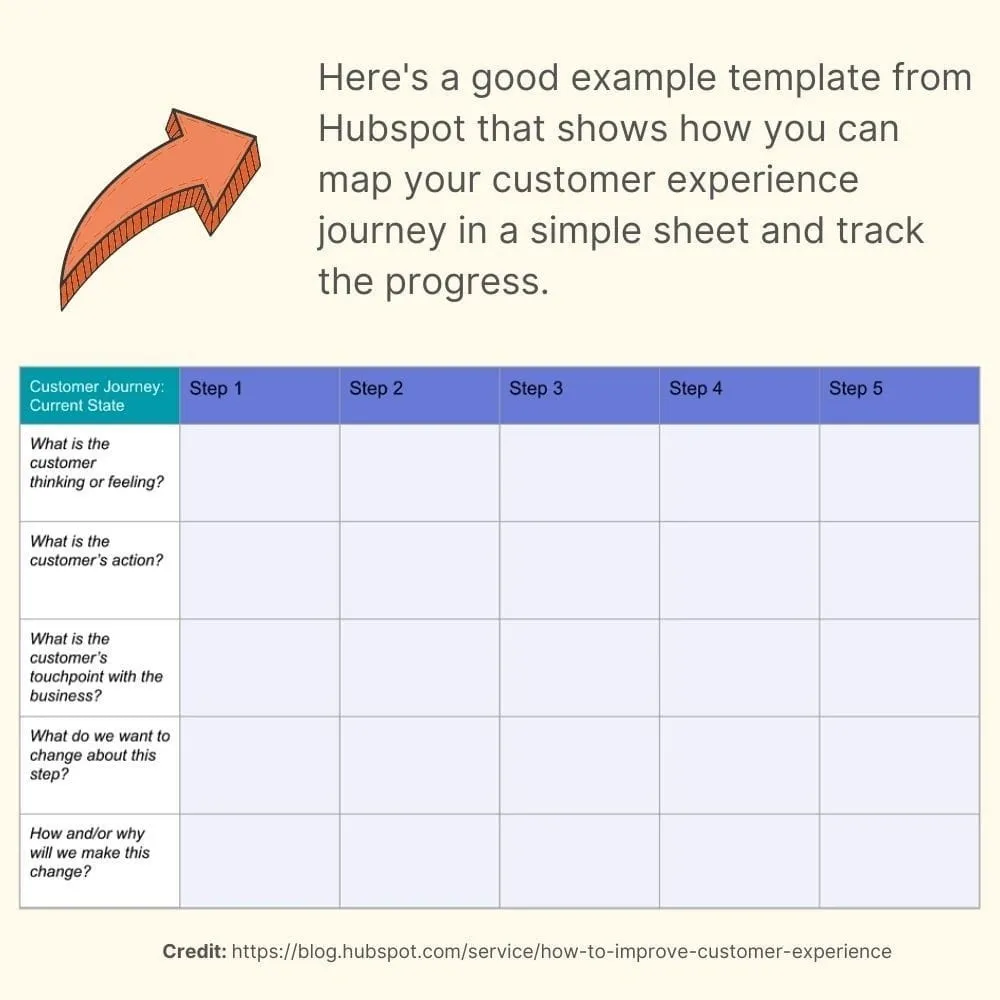On this page
Those who regularly roam with their eyes wide open in the marketing corridor are unsurprised to see the evolution of customer experience from a post-sale entity only to the new separate terrain of competitive marketing.
It’s strongly disruptive for those who believe that the tried and trusted duo of product and price alone will catapult them into the higher altitude of success.
Though experts had declared that the next decade would see a spectacle of customer experience trumping the product, the speed of change has preponed it, as it has already arrived.
This comprehensive guide to customer experience explains the actual meaning of customer experience, why it’s unavoidably important, and actionable methods that you can use to improve your organization’s resultant customer experience.
80% of customers say the experience a company provides is as important as its products and services.
49% of customers report having made impulse purchases after receiving personalized experiences.
Deloitte’s report highlights that three in four customers are more loyal to stores offering consistent customer experience.
A Forbes article notes that in 2024, 64% of customers stated that regardless of product enjoyment, poor customer service would lead them to seek alternatives.
What is customer experience?
A customer experience program is a structured strategy aimed at enhancing every interaction your business has with its customers. It centers on actively gathering feedback, understanding customer perceptions, and using those insights to make meaningful improvements.
Customer experience is the holistic impression that a customer has on a brand in every aspect of a buyer's journey. This impacts the bottom line of a brand, including revenue. (Source: Hubspot)
Many still mistake customer experience for just customer service. While service is a key part, CX is much broader—shaped by today’s complex, multichannel customer journeys. It spans every interaction between a customer and a brand, from touchpoints to environments. Simply put, customer experience has evolved into a multifaceted, dynamic system.
Why does customer experience matter for a business?
A good customer experience encourages loyalty and can turn consumers into brand advocates. On the other hand, bad experiences do just the opposite, and that’s the critical reason customer experience matters the most. Let’s also understand a few other vital reasons for its importance.
1. Customer satisfaction has never been as important as it has become now
The road to customer satisfaction goes through meeting customer expectations, which have metastasized rapidly.
Good customer experience, with detailed pre-sales information and humane post-sales interactions, can easily churn out more satisfied customers by not just meeting their expectations but even surpassing them.
It’s important to point out that companies across the globe have an average customer satisfaction rate of 86%, leaving a lot of scope for improvement.
2. Customer experience boosts the bottom line - both directly and indirectly
The economic value lies at the intersection of customers' expectations and the delivered customer experience. When customers interact with your organization, they want to extract maximum value through minimum input.
That's their idea of satisfaction. A good customer experience, thus, can positively impact their buying behavior and result in heightened revenue, reduced service cost, and improved ROI.
3. Customer experience guarantees business resiliency
Customer-centric organizations are often rewarded by the market and customers. A great customer experience implicitly means that you have adapted to the customer needs well by designing end-to-end customer journeys that focus on customer relationship management.
It gives your business more resilience, shielding you from customer wrath and price sensitivity.
4. Customer experience ensures competitive advantage
A 2024 study by Forrester revealed that companies with superior customer experience (CX) achieve up to 3.5 times more revenue growth compared to their competitors, emphasizing the critical role of CX in driving business success.
It then sounds perfectly logical why Tony Alessandra, President of Assessment Business Center, says: "Being on par in terms of price and quality only gets you in the game. Service wins the game.”
There is always a possibility that competitors may replicate the quality, product, and price dynamics you have but the touch of individualization and personalization that customer experience brings can be your own thing. It can become your product itself, and that's very hard to replicate, if not impossible.
How to improve customer experience?
The benefits that a class-apart customer experience bequeaths upon companies are indeed tempting, making anyone put a foot on the experience pedal impulsively.
However, the reality is barring the top-of-the-shelf companies, very few have grasped it comprehensively and have made it their own exclusive expert.
A slew of hampering - not knowing what exactly customers want, where they are, how to be there for them when they need you, clueless about adding value through customer experience - have impeded their customer experience endeavors.
The only way out is to decide key cornerstone actions involving a deeper understanding of customers and their surroundings and devising other subsidiary actions that revolve around them.

Here are the ten effective ways that can help in improving customer experience:
1. Map the customer journey judiciously
Understand your customer as clearly as you understand your own needs. Knowing first-handedly where customers come from, how they land on your various touchpoints, what they go through while traversing those touchpoints, and what they expect is the only reliable foundation on which the edifice of a stellar customer experience can be built.
Enunciating a clear customer journey map is, thus, the prime and first mover of customer experience.

A customer journey map is a detailed sketch of every step your customers pass through while interacting with your organization—and that’s why it includes engagements beyond just buying the product, like social media, advertisements, and case studies on your website.
Since customer experience is holistic in nature, it’s essential to include both post-sales and pre-sales activities in your mapping.
Though companies often focus more on sales-driving activities, paying attention to post-sales interactions is key—not just for a complete customer experience, but also for fostering customer retention.
Why is it important to map your customer journey?
A well-mapped customer journey gives your employees a cradle-to-grave overview of customer experience, helping them visualize pain points and their solutions.
Once employees recognize their individual contributions, superior customer experience naturally becomes a cultural touchstone across the organization.
2. Hone in the omnichannel strategy
Once you have listed the various modes through which customers can discover you and interact with you, the next step is to understand how customers behave on those channels and loop it seamlessly into your sales and marketing framework.
Note that this doesn’t just enhance your possibilities of getting in touch with your customers. But this is what customers want openly as well as secretly.
According to CX Today, 9 out of 10 customers expect an omnichannel experience as their go-to communication method.
This expectation for omnichannel experience stems from two reasons:
- Reason #1: Customers want a homogeneous, consistent, and familiar experience across all channels, making any kind of silos a sin.
- Reason #2: In an almost avalanche-esque plethora of gadgets, customers expect joy and freedom of interacting through the mode of their preference. Expecting customers to prefer only one mode of communication, thus, is a sure way to plant you in the pot of irrelevance.
Why is it important to adopt an omnichannel approach?
Empowered convenience: Freedom of interaction anytime and anywhere through preferred modes translates into convenience—the core of great customer experience. It helps identify moments when customers are ready to act. Google calls these “micro-moments”—intent-driven decisions and preferences that shape the consumer journey. Without open, integrated communication, leveraging these moments is like drawing lines on water.
Roping in the power of data: Omnichannel strategies generate recurring, actionable data—forming a rich base of consumer insights. Using this data scientifically helps you respond to needs and trends proactively. It also highlights friction points in the customer journey that can be resolved with this newfound clarity.
Common friction points:
- Complaint forms are too lengthy
- Call-to-action is buried in complex navigation
- The right content is hard to find
- Pop-ups intersect the key acts
- Re-entering the same information on multiple pages
- Challenges with using various devices
- No FAQ’s
3. Ace the artificial intelligence (AI)
Customer pains know no time clock. Sometimes, it’s humanly impossible to be there at all times for your customers. AI, with chatbots, can fill that glaring vacuum efficiently.
Infused with deep learning and advanced algorithms, they speed up response time and answer 80% of FAQs. Consequently, chatbots can save up to 30% in customer support costs.
Why is it important to have chatbots?
- Chatbots answer customer queries 24*7 even when your support team isn’t available. Ensuring prompt answers helps customers feel valued, the lynchpin of any good customer experience.
- Implementing bots as the primary customer contact can collect basic customer details that further the analysis.
- As opposed to humans, bots can be easily scaled during rush hours to deliver quality support without missing even an iota of conversation.
It’s then highly unsurprising that 30% of US consumers rate chatbot interactions as “very effective” in dealing with customer service issues. Why do you think this is possible? Activation functions make it possible to automate conversations - an impressive feat, indeed!
4. Integrate in-built self-service options
However well-trained your customer support team may be, it's still a reactive solution to recurring minor issues—leading to delays and added costs. A smarter strategy is to let customers resolve small, non-critical problems themselves.
This frees your support team to focus on urgent concerns that truly matter—often saving churn-risk customers. Even users prefer solving basic issues independently.
Why is it important to integrate in-built self-service options?
Self-service delivers what traditional support often cannot: fast, intuitive, and satisfying experiences. It empowers customers by:
- Bringing needed info instantly through smart navigation.
- Providing tools to fix small problems independently.
- Strengthening your brand by enabling frictionless interactions.
5. Deliver emblematic customer service
There are abundant scenarios where customers have churned out despite being satisfied with the product. More often, the usual suspect is bad customer service.
And with 78% of customers backing out of purchase due to poor customer service, one doesn’t have to burden his eyes with binoculars to see the detrimental impact that it can have on the financial nerve of a company.
Usually, great customer service means a service that is:
- Fast (“real-time”)
- Personalized
- Experiential
- Proactive, giving out a resolution before an actual disruption occurs
6. Listen to customers—always
Your customer’s perception is your brand’s reality. Unadulterated understanding of what they expect, what they feel about their collaboration with you, what are the areas of improvement, their willingness to recommend your brand to others, thus, becomes vitally important.
The best way is to connect with your customers through all the possible channels and ask for feedback regularly.
55% of consumers emphasized the importance of knowledgeable employees in their customer service experiences.
When condensed in the tube of analysis, companies can use these nuggets of information in upping the ante of customer service.
Why is it important to always listen to customers?
- Careful implementation of feedback ensures that the end product and customer service will meet customer expectations and thereby make customers happy.
- The sheer hard work that goes into collecting feedback shows that you value your customers’ opinions, making them feel closely attached to your company.
- Honest, regular, and detailed feedback helps quantify the client satisfaction quotient and opens up new opportunities for upselling and cross-selling.
7. Learn from customer churn
Bain & Company suggests that a 5% increase in customer retention can increase your company's profits by 25% to 95%. It begins by analyzing the customer experience areas where there is low engagement.
Even if you fail to prevent the churning, try to find out why they left. Ask them to leave feedback and think about it seriously. Figure out the instances where your company fell short and pass it on to the people concerned for a future remedy.
By making it easier for the customer to cancel his account and letting him go graciously, leave a good last impression—so when he decides to opt-in for the same product, you will be the first person to pop up in his mind.
Why is it important to prevent churn?
- Since low engagement is the precursor to the final, if not inevitable, churning, analyzing it lets you identify the customers who have the highest risk of churn.
- You can also gauge what percentage of engagement will cause churn and alert your customer success team about the same. It gives you the chance to proactively connect with customers before it's too late.
8. Engage with your customers throughout their life cycle
With countless touchpoints and new gadgets, the modern customer journey is far from linear—it’s full of twists and turns.
To prevent drop-offs, guide customers carefully through each stage.
Since 80% of consumers switch after multiple bad experiences, strong customer experience is essential to move them down the funnel.
Smart Insights found that 50% of companies view journey-based CX as “extremely important,” with 30% saying it’s “very important.”
To excel, closely observe the journey and fix friction points—like a slow website at the awareness stage or lengthy demo forms at decision-making.
Removing these hurdles with excellent CX ensures you meet customers at the finish line.
Why engage customers throughout the journey?
- It boosts lifetime value and ROI.
- Strong CX reduces long-term marketing spend.
- Happy customers become advocates, making ads less necessary.
9. Build a customer-centric culture
A business can’t succeed without happy, satisfied customers. Customer-centricity is a strategy and culture that focuses on delivering great experiences to build loyalty. It’s about putting the customer at the heart of everything—without draining your budget. Even small gestures can go a long way in making customers feel valued.
- Delight your customers with gifts: Since the world is yet to see a joyous way of delighting a person than a souvenir of choice, strategic sparkling of gifts on customers’ key personal or professional moments can grant you a permanent space in their good books.
- Grant them early access: A simple way to make your customers feel special is to provide early access to the newly launched product or services.
- Shower discounts on high-spending customers: Raise your order value as well as repeat purchase rates by offering measured discounts to your regular buyers.
Why is it important to build a customer-centric culture?
A customer-first approach makes people feel valued and central to your business. This emotional connection keeps your brand top of mind, increases their tolerance for small slip-ups, and lowers price sensitivity—helping reduce churn.
It echoed unequivocally in the research by Deloitte and Touche: Customer-centric companies are 60% more profitable compared to non-customer-centric companies.
10. Impart customer experience data to all teams
Customer experience is a grueling, never-ending battle that ought to be fought by the entire organization - and your CX team is handling just one front of it.
That’s why it’s imperative of the highest order that everyone in your organization has easy access to your customer experience findings.
This constant and first-hand brush with reality will help them introspect their work, causing optimization of daily yet mission-critical processes such as customer routing, workflow automation, and client tagging.
Why is it crucial to impart customer experience data to your teams?
- Quicker customer redressal: Metasaas mentions that 31% of SaaS licenses end up unused, highlighting the need for clearing roadblocks as quickly as possible. Having real-time and comprehensive data regarding where your customers are likely to face obstacles enables your team to foresee user frustration and opt-in for proactive measures to smoothen the customer's journey.
- Enhanced upsell opportunities: With an acute understanding of the right timing to reach out to customers, their preferred channels of communication, and their pressing needs, your sales team will be able to see newer upselling opportunities as clearly as daylight.
How to measure customer experience thoroughly?
There are two primary methods to evaluate customer experience:
- Customer Surveys: Directly ask customers about their experiences by sending surveys after an interaction.
- Support Data Analysis: Track first-party customer support metrics to understand the quality, speed, and efficiency of the service your team is providing.
The most effective approach combines both methods. Customer service KPIs set performance benchmarks, while surveys offer direct feedback from customers, revealing how well you're truly meeting their expectations.
There are hundreds of CX metrics you could track, but some are universally important across industries. Let’s dive into the most critical ones:
1. Net Promoter Score (NPS)
Net Promoter Score measures customer loyalty by asking a simple question:
“How likely are you to recommend us to a friend or colleague?”
Responses are rated on a scale of 0 to 10:
- 0–6: Detractors (unhappy customers)
- 7–8: Passives (satisfied but not enthusiastic)
- 9–10: Promoters (loyal enthusiasts)
To calculate your NPS, subtract the percentage of detractors from the percentage of promoters. A high NPS suggests customers love your brand and are willing to advocate for it.
2. Customer Satisfaction (CSAT)
CSAT is another widely used metric gathered through simple, one-question surveys such as:
“How satisfied were you with your experience?”
Responses typically offer options like "Satisfied" or "Dissatisfied," often with an optional comment box.
Businesses can send CSAT surveys after support interactions, or at different customer touchpoints like after product delivery or online purchase. Tracking CSAT across various stages helps you pinpoint exactly where improvements are needed.
3. Customer Effort Score (CES)
Customer Effort Score measures how easy it is for a customer to complete an action, such as solving an issue or making a return.
Customers are asked:
“How easy was it to get your issue resolved today?”
Responses typically range from “Very easy” to “Very difficult.” CES helps businesses uncover friction points in processes like checkout, support, or product usage — revealing opportunities for streamlining and improvement.
4. First Response Time (FRT)
First Response Time tracks the average time it takes for a customer to receive an initial reply from a human agent (not an automated confirmation).
Fast response times significantly boost customer satisfaction. Whether it's through email, chat, or messaging apps, customers expect timely replies. Reducing FRT can lead to happier, more loyal customers.
Keep in mind that expectations vary by channel: live chat users expect near-instant responses, while email users may tolerate a slightly longer wait.
Time of ticket submission – Time of first response after ticket is submitted = First response time
5. Average Resolution Time (ART)
Average Resolution Time measures how long it takes to completely resolve a customer's issue from the moment they first reach out.
If a group of tickets has a consistently high ART, it’s a sign that workflows may need optimization. Solutions might include using templates, improving agent training, or introducing better self-help resources to speed up resolutions.
Customers care most about quick, complete solutions—not just quick replies.
Total time to resolve all tickets ÷ Total number of tickets resolved= Average Resolution Time
6. First contact resolution (FCR)
First Contact Resolution measures the percentage of support tickets resolved during the first interaction, without any follow-ups needed.
To calculate it, divide the number of tickets resolved on first contact by the total number of tickets received.
High FCR rates show that your team is efficient and that your processes are set up to solve customer problems effectively. A high FCR also reduces operational costs by lowering the volume of repeat interactions.
How rewarding and gifting can elevate customer experience
Integrating rewarding and gifting into your customer experience strategy helps you move beyond transactional relationships and build emotional resonance with your audience. It transforms everyday interactions into personalized, value-driven moments that leave lasting impressions. Here's how:
- Creates emotional impact
Thoughtful rewards generate positive emotions like joy, surprise, and appreciation. These moments build a strong emotional connection with your brand, making customers more likely to return and recommend your products or services. - Reinforces brand loyalty
When customers are appreciated with timely rewards—be it on birthdays, anniversaries, or after a milestone—they feel valued. This recognition fosters brand loyalty and encourages repeat purchases. - Drives customer engagement
Incorporating gamified rewards like badges, tiered benefits, or surprise gifts boosts engagement across channels. Customers are more likely to interact with your brand when they know there’s a meaningful benefit tied to it. - Differentiates your brand
A reward-rich experience sets your brand apart in a competitive market. It signals that your business cares not just about the sale, but about the customer's overall journey and satisfaction. - Encourages word-of-mouth and advocacy
Delighted customers share their positive experiences. Strategic gifting can convert satisfied customers into vocal brand advocates, amplifying your reach and credibility. - Personalizes the experience
Offering rewards that are relevant to customer behavior or preferences (e.g., gift cards, experiential gifting, or donations in their name) shows a deep understanding of individual needs—making your brand feel more human and relatable.
Final thoughts
Customer experience is no longer just a support function—it’s a key business differentiator. From mapping journeys and enabling omnichannel touchpoints to integrating self-service and AI, every improvement contributes to a more satisfying, consistent, and loyalty-driving experience.
To elevate this experience even further, integrate meaningful rewards and gifting into your strategy. With a powerful digital rewards platform like Xoxoday Plum, you can create personalized, scalable moments of appreciation that drive retention, satisfaction, and emotional loyalty.
Want to turn everyday interactions into unforgettable brand experiences? Book a free demo with Xoxoday Plum and transform your customer experience today.















